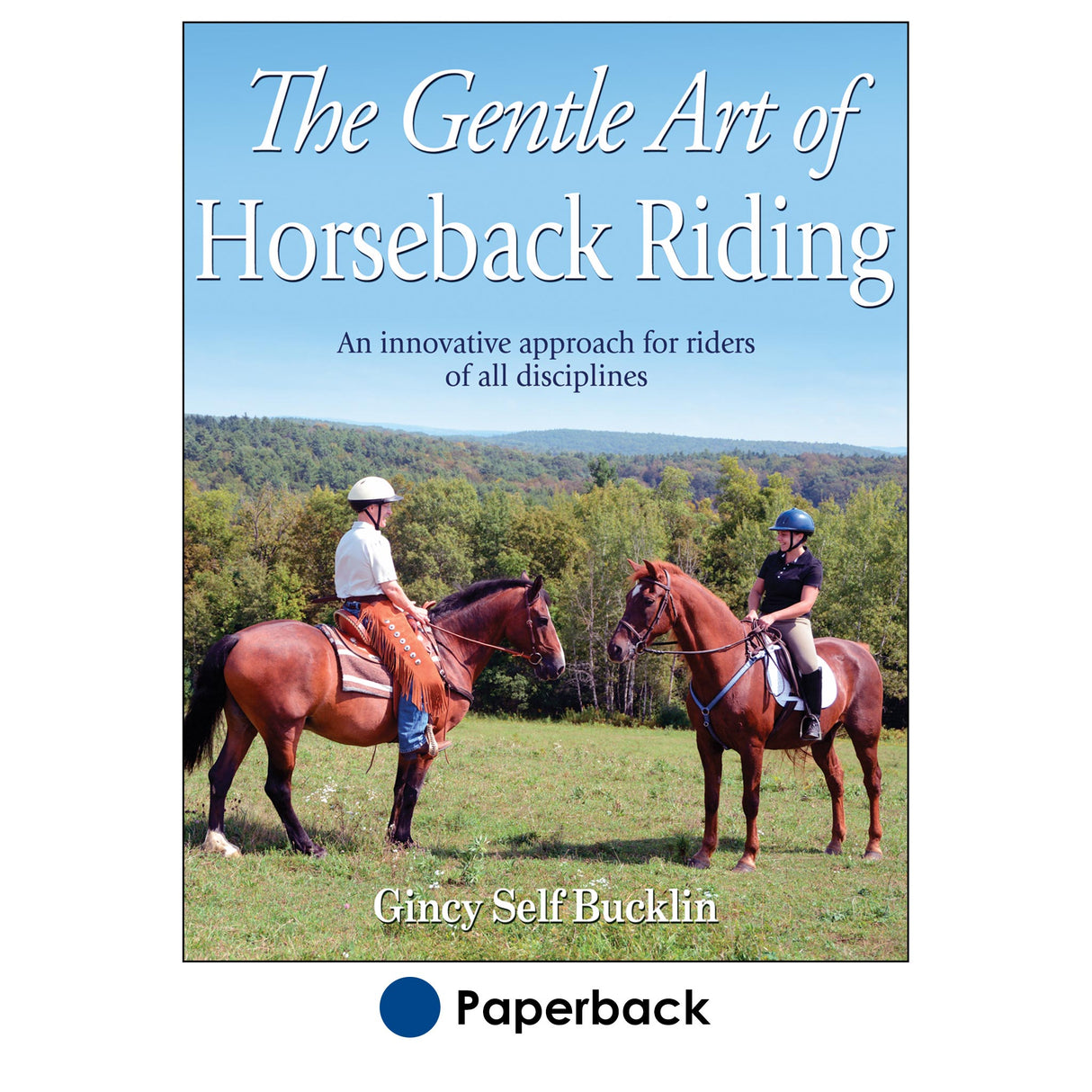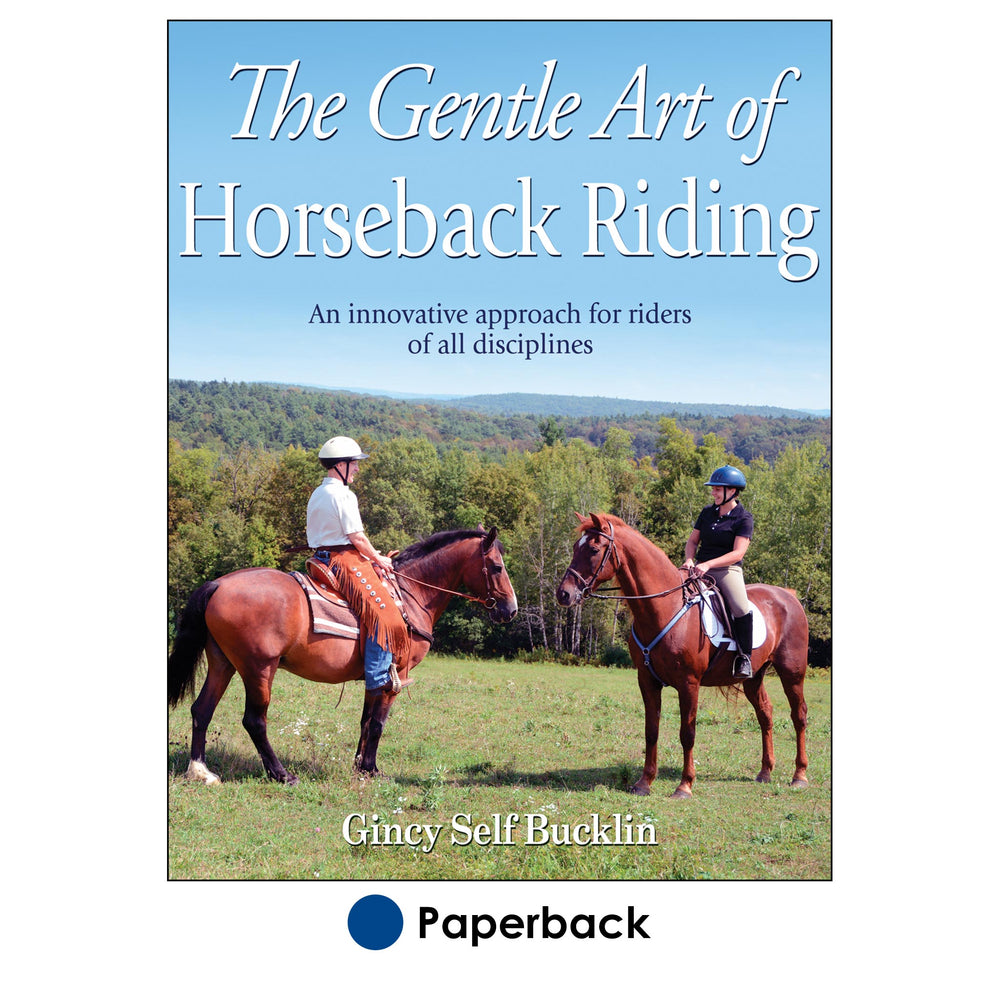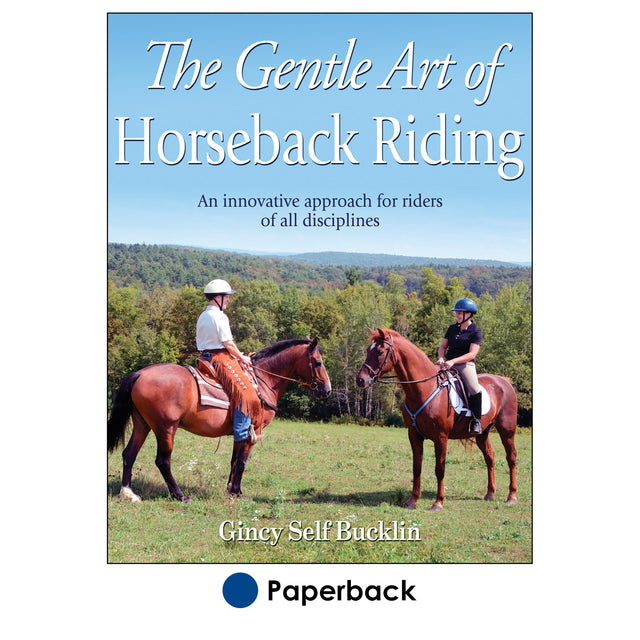Gentle Art of Horseback Riding, The
Author: Gincy Self Bucklin
$9.99 USD
Horseback riding is one of the world’s most popular activities. Much has been written about the various styles, techniques, and competitive events in the sport. But all too often resources, authors, and even instructors neglect the most important and unique aspect of riding: the relationship between rider and horse.
In The Gentle Art of Horseback Riding, Gincy Self Bucklin shares her horse-friendly approach for developing comfortable, competent riders. Its step-by-step lesson format makes it an excellent resource for those who teach riding to others.
Whether you are just beginning or have ridden before, Bucklin’s methods can improve your skills and make you a better, more confident rider.
Inside The Gentle Art of Horseback Riding, you’ll learn that the key to success at every level is understanding your horse and how to relate to him physically, mentally, and emotionally. This will help you advance more quickly, feel more confident, and have more fun.
You’ll also discover much, much more:
• The seven steps for dealing with fear-related stress
• Interpreting your horse’s behavior and body language
• Saddling up, riding in half-seat positions, and using the reins
• Basic movements, including walk, trot, canter, turns, and transitions
ò More advanced trotting, cantering, galloping, hill work, and fence jumping skills
Whether you have a serious or casual interest in the sport as a whole or just one of its many disciplines, The Gentle Art of Horseback Riding is a must-read. Insightful and fascinating, it will enhance the riding experience for you and your horse.
Chapter 1 Starting out Right
Why you Need Professional Instruction
Finding the Right Instructor
Riding Attire
Chapter2 The Real Tools for Success
The Three Basics
The Seven Steps and Grounding
Safety Guidelines
Chapter 3 Getting to Know the Horse
Handling the Introduction in a Closed Space
Getting Acquainted Out in the Open
Grooming
Chapter 4 Overcoming Your Natural Fear of Falling
Mounting in Baby Steps
Dismounting Safely
Preparing for the Emergency Dismount
Getting Comfortable On the Horse
Chapter 5 Taking Your First Real Ride
Using the Bareback Pad to Achieve a Secure Seat
Using the Grounding Strap
Mounting: Getting It Right From the Start
Following the Motion
Lateral Centering
Putting It All Together
Chapter 6 The Indispensable Halter and Staying Centered During Turns and Transitions
Rope Halters
Leather or Nylon Halters
Checking the Fit of the Halter
Staying Laterally Centered
Longitudinal Centering During Transitions
Chapter 7 Negotiating Simple Ground Movements
Achieving Cooperation Through Communication
Moving The Horse’s Hindquarters
Moving The Horse’s Forehand
Moving the Horse Backward
Chapter 8 Gaining Respect and Becoming the Leader
The Leadership Position
Dealing with Resistance
Starting and Stopping
Turning
When the Horse Wants to Take Over
Using The Stick for Gentle Persuasion
Chapter 9 Expanding Your Ground Skills
Leading the Horse Into the Stall
Bringing the Horse Out of the Stall
Cleaning the Horse’s Feet
Tacking Up the Horse With the Bareback Pad
Chapter 10 The Gentle Riding Aids
Understanding and Applying Intent
Using Your Eyes
Moving Your Center
Using Your Seat
Managing Your Weight
Using the Stick While Riding
Eliminating the Need for Aggression
Chapter 11 Handling the Reins and Preparing to Ride Solo
Picking Up the Reins
Lengthening the Reins
Shortening the Reins
Using the Grounding Strap and Stick with the Reins
The Sitting Trot or Jog
A Taste of Freedom
Chapter 12 Introduction to Riding In the Saddle
Preparing for Saddle Work
Mounting the Saddled Horse
Tightening the Girth While Mounted in the English Saddle
Dismounting From the Saddled Horse
Getting Comfortable
Your First Ride in the Saddle
Chapter 13 Saddling Up and Starting With Stirrups
Putting On the Saddle
Starting With the Stirrups
The n Position
The A Position
The Full Seat Forward Position
Sitting the Trot In the Saddle
Chapter 14 Half-Seat Positions and Preparing for Faster Gaits
Staying Grounded in the Half Seat
Working From the Hip Joint
Using the Grounding Strap in the Half Seat
Three-Quarter Seat Position
Half-Seat Open Position
Half-Seat Closed Position
Chapter 15 Bits, Bridling, and Introduction to Using the Reins
Putting On the Bridle
Using Hand Effects and Rein Effects to Communicate
The Active Hand
Introduction to the Leading Rein (English or Western Snaffle)
Introduction to Neck Reining (Western Curb)
Slowing or Stopping Using Direct Reins of Opposition (English or Western Snaffle)
Stopping Using Direct Reins of Opposition (Western)
Chapter 16 Perfect Posting
Finding Posting Rhythm on the Bareback Pad
Posting in the Stirrups
Understanding Diagonals
Chapter 17 Cantering (Loping) and Galloping (Running)
Preparing to Canter
Bareback Cantering to the Left
Bareback Cantering to the Right
Cantering or Loping in the Saddle
Cantering in Half-Seat Position
Galloping or Running
Chapter 18 Leg Aids and Advanced Hand and Rein Effects
The Soft Leg
The Passive Hand
The Holding Hand
The Fixed Hand
Combing the Rein
The Taking Hand
Types and Applications of Leading Reins and Reins of Opposition
Developing Effective Aids.
Chapter 19 Handling Hills With Confidence
Riding Uphill In an English Saddle
Riding Downhill In an English Saddle
Polishing Your Skills
Handling Hills in a Western Or Other Deep-Seated Saddle
Putting Your Skills to Good Use
Chapter 20 Jumping Made Easy
Phases of the Jump
Staying Centered During the Jump
Teaching Your Body to Ride the Jump
Trusting the Horse
Giving the Horse His Head
Jumping Courses
Refusals and Runouts
Jumping for Western Riders
"Whatever your discipline, Gincy Bucklin’s innovative approach to learning the essential skills will help you become a confident rider on a calm, comfortable horse.”
Charlotte Kneeland-- Founder of the American Riding Instructor's Association
"The Gentle Art of Horseback Riding will be a valuable resource for those riders who are not lucky enough to take lessons directly from Gincy herself."
Jessica Jahiel--Author of Horse-Sense Newsletter and The Horse Training Problem Solver, Horse Training Consultant
"Hands-on experience is the best teacher, and Gincy transmits this knowledge and experience through The Gentle Art of Horseback Riding. Anything Gincy writes is worth a read."
George H. Morris-- Legendary Trainer,
1960 Olympic Silver Medalist in Show Jumping “Gincy very deeply takes into consideration that a horse has feelings and personality and deserves to be treated with consideration, so the partnership is a mutual, respectful exchange. This book is a must for every rider, be he a beginner, fairly advanced, or of an upper level. It is also a great help for trainers who are teaching young horses the basics, then higher levels of being ridden in a relaxed, balanced, happy way. For riding instructors, this book will give very valuable insight on how to build up lessons and step-by-step teaching of their students.”Yvonne LeheyHow to post in stirrups
Mastering the sitting trot or jog
Take a leadership position and learn to deal with resistance
 Bucklin - Fastening the rope halter
Bucklin - Fastening the rope halter Bucklin - Gaining respect and becoming the leader
Bucklin - Gaining respect and becoming the leader Bucklin - Leadership position
Bucklin - Leadership position Bucklin - Putting on the rope halter
Bucklin - Putting on the rope halter 





